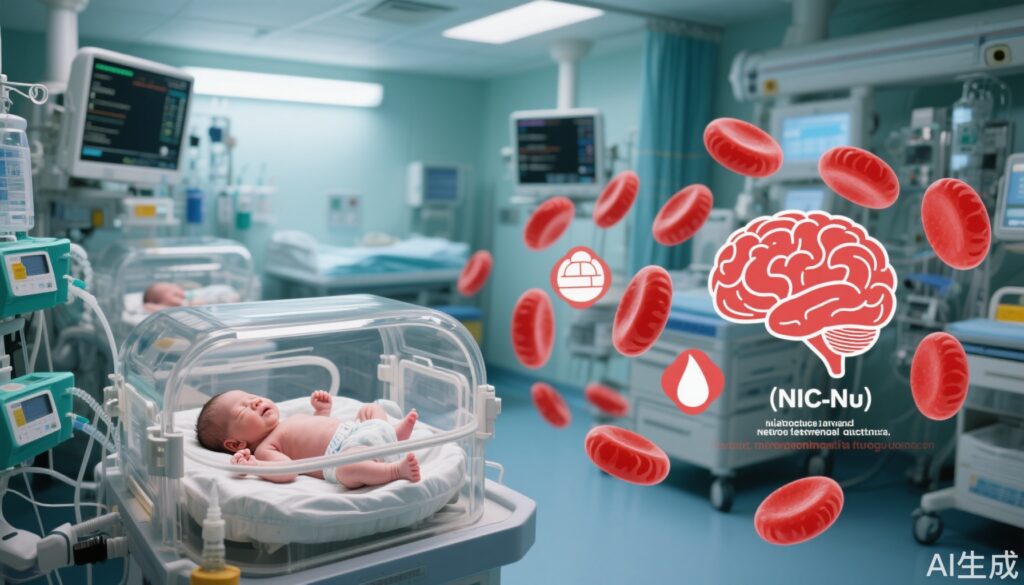Highlights
- Darbepoetin significantly increased red cell mass and reduced the frequency of transfusions and donor exposures in preterm infants.
- No improvement in neurocognitive outcomes was observed at 22-26 months’ corrected age compared to placebo.
- Incidence of major adverse effects, including retinopathy of prematurity, was not increased with darbepoetin.
- Darbepoetin was associated with a lower risk of moderate or severe bronchopulmonary dysplasia.
Study Background and Disease Burden
Premature birth remains a major global health challenge, affecting over 10% of all live births. Extremely preterm infants (born before 29 weeks’ gestation) frequently require red blood cell transfusions due to iatrogenic blood loss, immature erythropoiesis, and critical illness. Multiple transfusions expose these infants to donor blood, with attendant risks of infection, immunologic reactions, and potential long-term impacts on neurodevelopment. Additionally, preterm infants are at heightened risk for neurodevelopmental impairments due to both cerebral immaturity and perinatal complications. Previous observational and smaller randomized studies have suggested that erythropoiesis-stimulating agents (ESAs) like erythropoietin and its analogue darbepoetin may reduce transfusion needs and possibly improve neurodevelopmental outcomes, but robust, adequately powered trials have been lacking.
Study Design
This was a multicenter, double-blind, randomized, placebo-controlled trial conducted at 19 US Neonatal Research Network centers, encompassing 33 neonatal intensive care units. Infants born between 23 0/7 and 28 6/7 weeks’ gestation were eligible and enrolled within 36 hours of birth. Participants were randomized to receive either weekly subcutaneous darbepoetin (10 μg/kg) or an identical placebo, administered until 35 weeks’ postmenstrual age. All infants received standardized iron supplementation and transfusion protocols. The primary endpoint was the mean cognitive composite score on the Bayley Scales of Infant Development, third edition (Bayley-III), assessed at 22 to 26 months’ corrected age. Infants who died before assessment were assigned the lowest possible score. Key secondary outcomes included transfusion exposure, red cell mass, donor exposure, incidence of bronchopulmonary dysplasia (BPD), and retinopathy of prematurity (ROP). Safety endpoints included adverse event monitoring.
Key Findings
A total of 650 infants were randomized (322 to darbepoetin, 328 to placebo), with a mean gestational age of 26.2 weeks. The primary outcome was available for 583 infants (90% of the cohort).
Neurocognitive Outcome:
The mean (SD) Bayley-III cognitive composite score was 80.7 (19.5) in the darbepoetin group versus 80.1 (18.7) in the placebo group. The adjusted mean difference was -0.23 (95% CI, -3.09 to 2.64), indicating no statistically or clinically significant difference. Thus, darbepoetin at this dose and regimen did not improve cognitive outcomes at 22-26 months’ corrected age.
Hematologic and Transfusion Outcomes:
– 40% of infants in the darbepoetin group remained transfusion-free during hospitalization compared to 21% in the placebo group (adjusted RR 1.3, 95% CI 1.2-1.5).
– The mean number of transfusions was lower with darbepoetin: 2.3 (3.1) versus 3.3 (3.5) in the placebo arm.
– Fewer donor exposures were recorded in the darbepoetin group (mean 1.6 vs. 2.2 donors).
– By week 2 of age, darbepoetin recipients had significantly higher red cell mass (adjusted mean difference 3.2, 95% CI 1.7-4.7) and higher mean hematocrit (2.8, 95% CI 2.1-3.6).
Respiratory and Ophthalmologic Outcomes:
– The risk of bronchopulmonary dysplasia greater than grade 1 was lower in the darbepoetin group (35% vs 46%; RR 0.78, 95% CI 0.64-0.96).
– Rates of severe retinopathy of prematurity (stage >2) were similar between groups (13% vs 16%).
Safety:
No significant differences in adverse events were observed between the two groups, supporting the safety of darbepoetin in this population.
Expert Commentary
This rigorously conducted, multicenter trial provides strong evidence that while darbepoetin confers hematologic benefits and reduces transfusion burden in extremely preterm infants, it does not translate into improved neurocognitive outcomes at early childhood. These findings align with the hypothesis that prevention of anemia and reduction of transfusion-related risks are achievable with ESA therapy, but neuroprotection may be more complex and not solely dependent on red cell mass or oxygen-carrying capacity. The lack of increase in severe ROP or other adverse events is reassuring, particularly given concerns about ESAs and proliferative complications. The observed reduction in moderate-severe BPD is intriguing and warrants further mechanistic investigation.
Limitations include the specific dose and schedule tested, which may not reflect the full potential neuroprotective window or mechanisms of darbepoetin. The Bayley-III, while widely used, may not capture more subtle or long-term neurodevelopmental benefits. Additionally, generalizability is limited to similar NICU populations with access to advanced supportive care and strict transfusion protocols.
Conclusion
Darbepoetin, administered weekly at 10 μg/kg in extremely preterm infants, effectively increases red cell mass and reduces transfusion and donor exposures without increasing major adverse events. However, this regimen does not improve neurocognitive outcomes at 22-26 months’ corrected age. The results suggest that while darbepoetin may offer transfusion-related advantages in the NICU, its use cannot be recommended solely for neuroprotection. Future research may explore alternative dosing, timing, or combinations with other neuroprotective strategies.
References
1. Ohls RK, Das A, Tan S, Lowe JR, Schibler K, Beauman SS, Bell EF, et al.; Eunice Kennedy Shriver National Institute of Child Health and Human Development Neonatal Research Network. Darbepoetin, Red Cell Mass, and Neuroprotection in Preterm Infants: A Randomized Clinical Trial. JAMA Pediatr. 2025 Aug 1;179(8):836-845. doi: 10.1001/jamapediatrics.2025.0807. PMID: 40354084; PMCID: PMC12070281.
2. Widness JA, Veng-Pedersen P, Peters C, et al. Erythropoietin pharmacokinetics in preterm infants: Implications for clinical use. J Pediatr. 1996;128(4):522-527.
3. Juul SE, Comstock BA, Heagerty PJ, et al. High-dose erythropoietin for asphyxia and encephalopathy (HEAL): a randomized clinical trial. JAMA. 2020;324(6):529-538.



